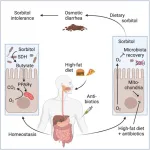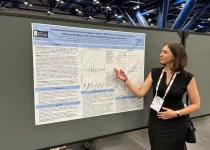(Press-News.org) (SACRAMENTO, Calif.) — Researchers at UC Davis have identified changes in the gut microbiome that can result in an inability to digest sorbitol.
Sorbitol, a sugar alcohol, is used in sugar-free gum, mints, candy and other products. It is also found naturally in apricots, apples, pears, avocadoes and other foods. At high levels, sorbitol can cause bloating, cramps and diarrhea. For some people, even a small amount causes digestive upset, a condition known as sorbitol intolerance.
A new study with mice found that taking antibiotics, combined with a high-fat diet, reduced the number of Clostridia gut microbes, which can break down sorbitol. The findings were published in the journal Cell.
“Our research suggests that microbial sorbitol degradation normally protects the host against sorbitol intolerance. However, an impairment in the microbial ability to break down sorbitol causes sorbitol intolerance,” said Jee-Yon Lee, first author of the study. Lee is an assistant project scientist in the UC Davis Department of Medical Microbiology and Immunology.
How oxygen levels in the gut affect microbes
The researchers used metagenomic analysis to identify which gut bacteria have genes that make the enzyme that breaks down sorbitol. They also identified which of those gut bacteria were plentiful before — but not after — antibiotic treatment.
This analysis allowed them to zero in on gut microbes belonging to the class Clostridium. Clostridium are anaerobic, meaning they don’t like environments with oxygen.
The researchers found that after the mice were given antibiotics and fed a diet high in saturated fat, the cells lining the gut used less oxygen. This created a higher level of oxygen in the gut, decreasing Clostridia. Without enough Clostridia, sorbitol was not broken down in the gut.
The researchers performed several experiments to try to restore the gut bacteria so it could break down sorbitol again.
In one, they fed the mice Anaerostipes caccae, a gut bacterium that produces butyrate. Butyrate is a short-chain fatty acid produced as part of the normal fermentation process in the gut. It enhances oxygen usage by the cells that line the gut, the epithelial lining, which reduces oxygen levels in the large intestine.
Regulating the oxygen level with Anaerostipes caccae restored the normal levels of Clostridia, which protected the mice from sorbitol-induced diarrhea, even after the butyrate-producing bacteria had been cleared from the mouse’s digestive system.
The researchers suggest that a drug used to treat ulcerative colitis, Crohn's disease and other inflammatory bowel diseases, mesalazine (5-aminosalicylate), may be a treatment for sorbitol intolerance in humans. Mesalazine, also known as mesalamine, functions similarly to the butyrate-producing bacteria, restoring the low oxygen levels in the intestine preferred by Clostridia.
“This discovery is crucial, given the prevalent use of sorbitol and similar sugar alcohols in the production of keto-friendly diet foods that are high in fat content," Lee said. “It also highlights the importance of oxygen consumption by the epithelial lining in the intestines in maintaining a healthy balance of gut bacteria, especially Clostridia, for proper digestion of certain sugars.”
An important limitation of the study is that mice can tolerate much higher sorbitol levels than humans. Mice possess a cecum — a pouch in their digestive system that slows the flow of intestinal contents and helps digest carbohydrates, which may contribute to being able to better tolerate sorbitol. Clinical studies will be needed to test the hypothesis that mesalazine could treat sorbitol intolerance in humans.
“Our study provides a completely new starting point for approaches to diagnose, prevent and treat sorbitol intolerance,” said Andreas Bäumler, senior author of the study. Bäumler is a distinguished professor and vice chair of research in the UC Davis Department of Medical Microbiology and Immunology.
Co-authors include Connor Tiffany, Scott Mahan, Andrew Rogers, Henry Nguyen and Hugo Masson of the UC Davis School of Medicine; Eric Stevens and Maria Marco of UC Davis; Matthew Kellom and Emiley A. Eloe-Fadrosh of Lawrence Berkeley National Laboratory; Kohei Yamazak of Kitasato University in Japan; and Peter Turnbaugh of UC San Francisco (UCSF) and Chan Zuckerberg Biohub.
END
Do sugar-free candy and gum give you gas? Researchers think they know why
Missing gut microbes after antibiotics and a high-fat diet may be to blame for ‘sorbitol intolerance’
2024-02-15
ELSE PRESS RELEASES FROM THIS DATE:
Health and zombie cells in aging
2024-02-15
With age, cells can experience senescence, a state where they stop growing but continue releasing inflammatory and tissue-degrading molecules. When a person is young, the immune system responds and eliminates senescent cells, often referred to as zombie cells. However, zombie cells linger and contribute to various age-related health problems and diseases. Mayo Clinic researchers, in two studies, shed light on the biology of aging cells.
In a study published in Aging Cell, Mayo Clinic researchers analyzed zombie ...
Early-stage subduction invasion
2024-02-15
Contributed by Arianna Soldati, GSA Science Communication Fellow
Our planet’s lithosphere is broken into several tectonic plates. Their configuration is ever-shifting, as supercontinents are assembled and broken up, and oceans form, grow, and then start to close in what is known as the Wilson cycle.
In the Wilson cycle, when a supercontinent like Pangea is broken up, an interior ocean is formed. In the case of Pangea, the interior ocean is the Atlantic. This ocean has a rift in the middle, and passive margins on the side, which means no seismic or volcanic activity occurs along its shores. Destined to keep expanding, an Atlantic-type ...
Targeting the transporter
2024-02-15
When an enemy invades, defenders are ferried to the site to neutralise the marauders. In the human body, a protein carrier called SPNS2 transports S1P molecules from endothelial cells to rally immune cell response in infected organs and tissues.
Using specially-developed nanobodies that bind to SPNS2 and enlarge the entire structure, the enlarged SPNS2 structure allows the S1P molecules to be viewed via cryogenic electron microscopy. Scientists from the Immunology Translational Research Programme at the Yong Loo Lin School of Medicine, ...
AERA announces 2024 Fellows
2024-02-15
WASHINGTON, February 15, 2024—The American Educational Research Association (AERA) has announced the selection of 24 exemplary scholars as 2024 AERA Fellows. The AERA Fellows Program honors scholars for their exceptional contributions to, and excellence in, education research. Nominated by their peers, the 2024 Fellows were selected by the Fellows Committee and approved by the AERA Council, the association’s elected governing body. They will be inducted during a ceremony at the 2024 Annual Meeting in Philadelphia on April 12. With this cohort, there will be a total of 762 AERA ...
Hackensack meridian health biologist-turned-med student publishes COVID-19 vaccine study
2024-02-15
First-year Hackensack Meridian School of Medicine (HMSOM) student Elizabeth Titova leveraged her background in phlebotomy and scientific research to publish a new clinical study around COVID-19 vaccination in Microbiology Spectrum, a peer-reviewed, open-access ASM Journal.
In her study, Titova found that while naturally stronger in immunocompetent individuals, the immunocompromised population—”especially cancer patients undergoing treatment”—still received a “robust immune response” from the vaccine, indicating protection against SARS-CoV-2.
This ...
Burnout: identifying people at risk
2024-02-15
It is not uncommon for people to “hit the wall” at work and experience burnout for short or long periods of time.
“We have found that approximately 13 per cent of Norwegian employees are at high risk of burnout,” says Leon De Beer, Associate Professor of Work and Organizational Psychology at the Norwegian University of Science and Technology (NTNU) Department of Psychology.
De Beer has contributed to a new study on burnout published in the Scandinavian Journal of Psychology with colleagues from the Healthy Workplaces research group.
They are working on a new tool that can identify people at risk of burnout. ...
Study reveals accelerated aging in women living with HIV
2024-02-15
Women with HIV experience accelerated DNA aging, a phenomenon that can lead to poor physical function, according to a study led by Stephanie Shiau, an assistant professor in the Department of Biostatistics and Epidemiology at the Rutgers School of Public Health.
Published in The Journal of Infectious Diseases, the study sheds light on the unique challenges faced by women with HIV as they age and opens avenues for tailored interventions to enhance health outcomes. Globally, over 50 percent of individuals living with HIV are ...
How parents can help prevent the development of ADHD symptoms
2024-02-15
Parents of young children with an excitable or exuberant temperament could adapt their parenting style to help moderate their child’s potential development of Attention Deficit/Hyperactivity Disorder (ADHD), according to a new study co-authored by a University of Waterloo researcher.
Developmental psychologists know that temperament, parenting, and the brain’s executive functions are interconnected factors in developing ADHD symptoms throughout childhood. But, the study found specific factors that predict a higher chance of ADHD symptoms, pointing to the importance ...
Meow or rooaaar - exotic cats' ability to recognize familiar caregivers' voices
2024-02-15
In a recent PeerJ Life & Environment study, Professor Jennifer Vonk from Oakland University presents compelling evidence that exotic cats possess the remarkable ability to discriminate between familiar and unfamiliar human voices.
The article - "Catcalls: Exotic Cats Discriminate the Voices of Familiar Caregivers" - delves into the often-overlooked realm of voice recognition among Felidae species. While much attention has been paid to domestication and early experiences in understanding animals' ability to differentiate between ...
Dementia researchers share recruitment strategies for pragmatic clinical trial
2024-02-15
WINSTON-SALEM, N.C. – Feb. 15, 2024 – According to the Alzheimer’s Association, more than 6.5 million Americans are living with Alzheimer’s disease, and 1 in 3 older adults will die with the disease or another form of dementia. There’s also a growing need for improved care and support, not only for persons living with dementia but also for their caregivers.
Underrepresented populations are disproportionally more likely to have Alzheimer’s disease compared to other Americans, so there’s ...
LAST 30 PRESS RELEASES:
Injectable breast ‘implant’ offers alternative to traditional surgeries
Neuroscientists devise formulas to measure multilingualism
New prostate cancer trial seeks to reduce toxicity without sacrificing efficacy
Geometry shapes life
A CRISPR screen reveals many previously unrecognized genes required for brain development and a new neurodevelopmental disorder
Hot flush treatment has anti-breast cancer activity, study finds
Securing AI systems against growing cybersecurity threats
Longest observation of an active solar region
Why nail-biting, procrastination and other self-sabotaging behaviors are rooted in survival instincts
Regional variations in mechanical properties of porcine leptomeninges
Artificial empathy in therapy and healthcare: advancements in interpersonal interaction technologies
Why some brains switch gears more efficiently than others
UVA’s Jundong Li wins ICDM’S 2025 Tao Li Award for data mining, machine learning
UVA’s low-power, high-performance computer power player Mircea Stan earns National Academy of Inventors fellowship
Not playing by the rules: USU researcher explores filamentous algae dynamics in rivers
Do our body clocks influence our risk of dementia?
Anthropologists offer new evidence of bipedalism in long-debated fossil discovery
Safer receipt paper from wood
Dosage-sensitive genes suggest no whole-genome duplications in ancestral angiosperm
First ancient human herpesvirus genomes document their deep history with humans
Why Some Bacteria Survive Antibiotics and How to Stop Them - New study reveals that bacteria can survive antibiotic treatment through two fundamentally different “shutdown modes”
UCLA study links scar healing to dangerous placenta condition
CHANGE-seq-BE finds off-target changes in the genome from base editors
The Journal of Nuclear Medicine Ahead-of-Print Tip Sheet: January 2, 2026
Delayed or absent first dose of measles, mumps, and rubella vaccination
Trends in US preterm birth rates by household income and race and ethnicity
Study identifies potential biomarker linked to progression and brain inflammation in multiple sclerosis
Many mothers in Norway do not show up for postnatal check-ups
Researchers want to find out why quick clay is so unstable
Superradiant spins show teamwork at the quantum scale
[Press-News.org] Do sugar-free candy and gum give you gas? Researchers think they know whyMissing gut microbes after antibiotics and a high-fat diet may be to blame for ‘sorbitol intolerance’




